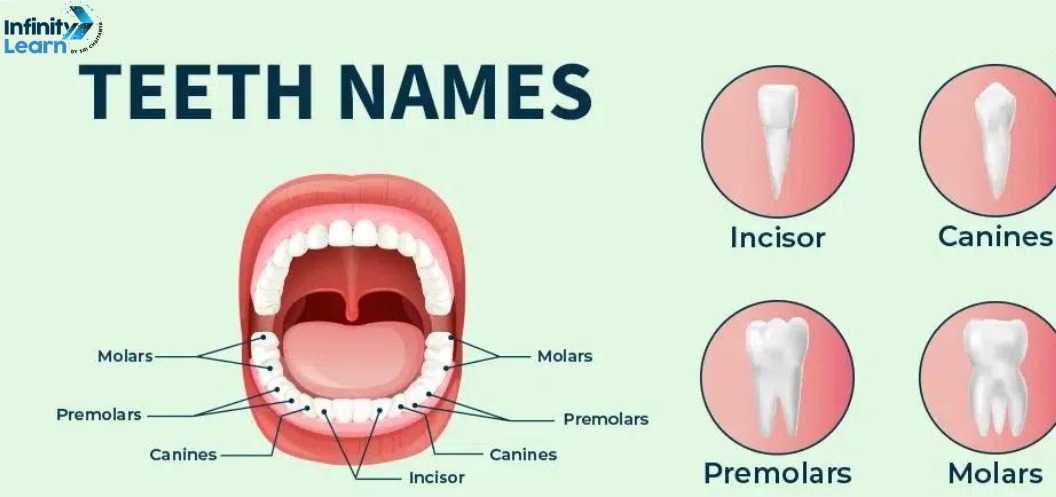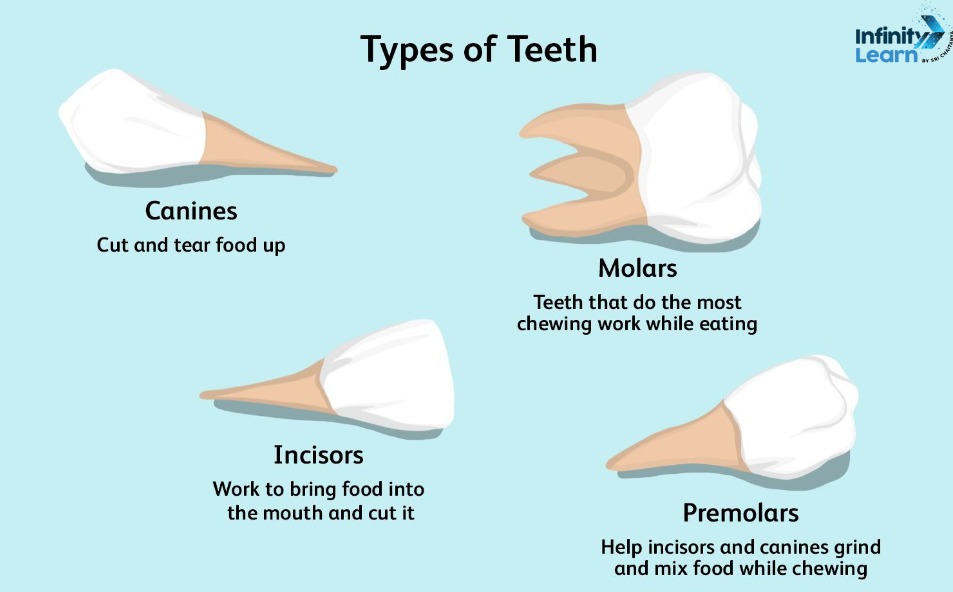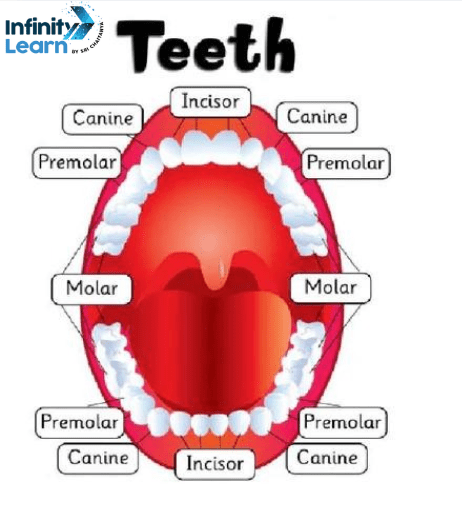Table of Contents
Understanding the names and functions of our teeth is essential for maintaining good oral hygiene and health. Here’s a comprehensive guide to help you learn more about the various types of teeth, their names, and their roles in our mouth.
All Teeth Names
Humans have 32 permanent teeth, each with a specific name and function. The four main types are incisors, canines, premolars, and molars. Let’s explore these in detail.

Types of Teeth Name

Below are the main types of teeth are:
Incisors
Incisor teeth are positioned at the front of your mouth, with four in the upper jaw and four in the lower jaw. Incisors are shaped like small chisels with sharp edges, which make them ideal for biting into food. When you bite into something like an apple, you primarily use your incisors.
Incisors are typically the first teeth to appear in infants, usually emerging around 6 months of age. The permanent set of incisors replaces the primary ones between the ages of 6 and 8.
Also Read: Human Teeth
Canines
Your four canine teeth are positioned adjacent to the incisors, with two located on the top of your mouth and two on the bottom. Canines are distinguished by their sharp, pointed surface, which is ideal for tearing food.
The first set of baby canines typically appear between the ages of 16 and 20 months. The upper canines usually emerge first, followed by the lower canines. For adult canines, the lower ones generally break through the gums first around age 9, with the upper canines following at around age 11 or 12.
Premolars
Your eight premolars are positioned adjacent to your canines, with four on the top and four on the bottom. Premolars are larger than canines and incisors, featuring a flat surface with ridges that help in crushing and grinding food into smaller pieces, making it easier to swallow. Unlike incisors and canines, infants and young children do not have premolars. These teeth begin to emerge around the age of 10, replacing the baby molars.
Molars
Your 12 molars are the largest and strongest teeth in your mouth, with six on the top and six on the bottom. The primary eight molars are categorized into 6-year and 12-year molars based on when they typically erupt.
The large surface area of molars allows them to effectively grind food. When you eat, your tongue moves the food to the back of your mouth, where the molars break it down into smaller pieces that are easier to swallow.
Molars also include four wisdom teeth, known as third molars, which are the last to emerge, typically between ages 17 and 25. Not everyone has sufficient space for these teeth, often leading to impaction, where the teeth are trapped under the gums due to lack of room. If impacted, wisdom teeth generally need to be removed.
Also Check: Fingers Name in English and Hindi
Front Teeth Name
The front teeth are known as incisors. There are eight incisors in total, with four located in the upper jaw (maxillary incisors) and four in the lower jaw (mandibular incisors). These teeth are designed for cutting food into manageable pieces.
Types of Incisors
- Central Incisors: The two front teeth in both the upper and lower jaws.
- Lateral Incisors: The teeth adjacent to the central incisors.
Function of Incisors
- Cutting Food: Incisors have sharp edges that help in cutting and slicing food.
- Aesthetic Role: They are prominently visible when you smile or talk, playing a crucial role in your facial aesthetics.
- Speech: Incisors also assist in the pronunciation of certain sounds.
Teeth Names in English
- Incisors: The eight front teeth (four upper and four lower).
- Canines: The four pointed teeth next to the incisors.
- Premolars: The eight teeth located between the canines and molars.
- Molars: The twelve teeth, including the wisdom teeth, at the back of the mouth.
Read More: GK Questions on Teeth Names
Teeth Parts Name
Each tooth has several parts:
- Crown: The visible part of the tooth.
- Enamel: The hard, outer surface of the crown.
- Dentin: The layer beneath the enamel.
- Pulp: The innermost part containing nerves and blood vessels.
- Root: The part embedded in the jawbone.
Last Teeth Name
The last teeth in the mouth are known as molars, specifically the third molars, which are commonly referred to as wisdom teeth. These are the final set of molars to emerge and typically appear between the ages of 17 and 25.
Teeth Images with Names

Teeth Numbers and Names
Dentists often use a numbering system to identify teeth. For example, the upper right first molar is numbered as 3, and the upper left first molar is numbered as 14. This system helps in accurately identifying and referring to specific teeth.
Teeth Name in Hindi
In Hindi, the teeth are referred to as follows:
- Incisors: कटनी (Katni)
- Canines: दाढ़ (Daad)
- Premolars: अग्रदंत (Agradant)
- Molars: पृष्ठदंत (Prishthadant)
Teeth Names in Arabic
In Arabic, the teeth names are:
- Incisors: القواطع (Al-Qawati’)
- Canines: الأنياب (Al-Aniab)
- Premolars: الضواحك (Al-Dawahik)
- Molars: الأضراس (Al-Adras)
32 Teeth Names
A full set of adult teeth includes:
- 8 Incisors
- 4 Canines
- 8 Premolars
- 12 Molars (including 4 wisdom teeth)
| Related Links | |
| Omnivores Animals Name | Birds Name |
| Weeks Name | Vegetables and Fruits Name |
FAQs on Teeth Names
Name the different types of teeth
The different types of teeth are incisors, canines, premolars, and molars.
Name the four types of teeth
The four types of teeth are incisors, canines, premolars, and molars.
What are the 32 teeth called?
The 32 teeth are called incisors, canines, premolars, and molars, including the wisdom teeth, which are also known as third molars.
What are the 5 teeth names?
Typically, teeth are categorized into four types: incisors, canines, premolars, and molars. However, if we include a fifth category, it could be the wisdom teeth (third molars) .
What are the 4 divisions of teeth?
The four divisions of teeth are incisors, canines, premolars, and molars.
What are the 4 main parts of a tooth?
The four main parts of a tooth are the enamel, dentin, cementum, and pulp.
What is tooth number 4 called?
Tooth number 4 is typically a premolar in the Universal Numbering System.









